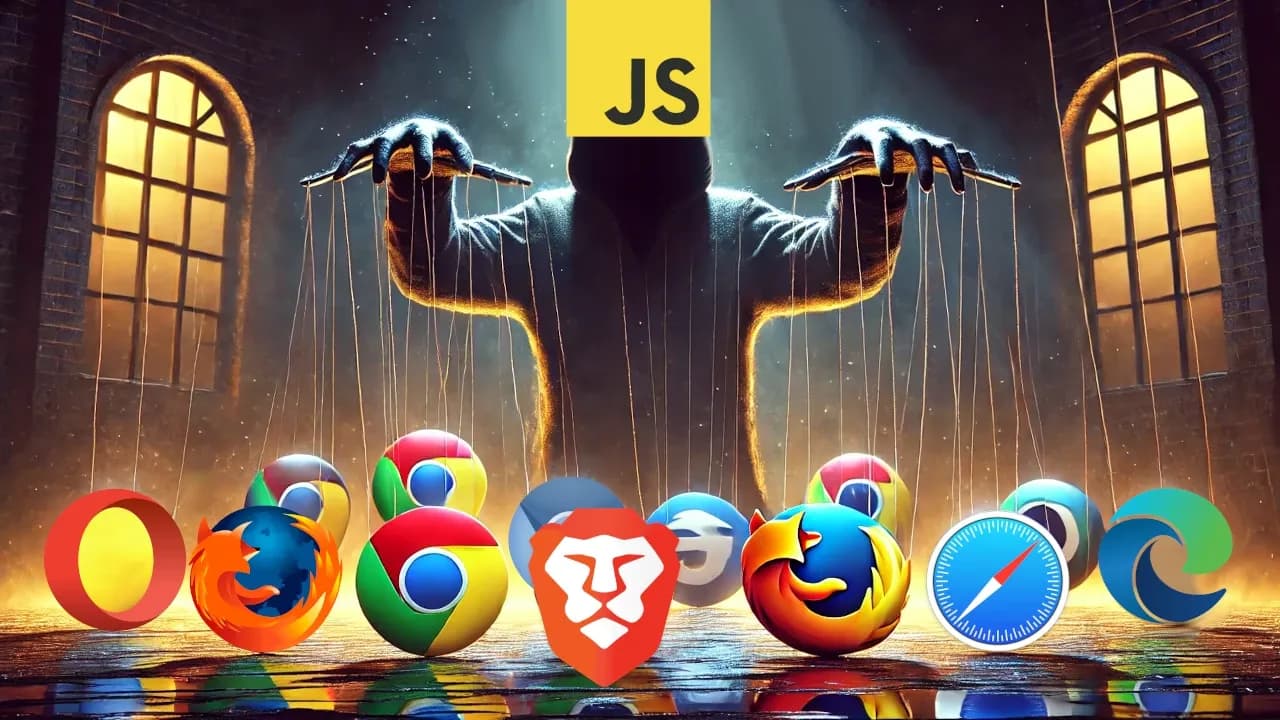This is not a complete guide on JavaScript browser APIs, but a quick overview of the most commonly used ones. Each of these APIs serves a unique purpose, enabling JavaScript to communicate with the browser and beyond. Let’s break them down.
1. Fetch API
The Fetch API provides a modern way to make HTTP requests from the browser. It’s a cleaner and more powerful alternative to the older XMLHttpRequest method. You can use it to request data from a server, like fetching JSON from an API, and handle the responses with promises.
Example:
javascriptfetch('https://api.example.com/data')
.then(response => response.json())
.then(data => console.log(data))
.catch(error => console.error('Error:', error));
2. XMLHttpRequest (XHR)
Before fetch(), the XMLHttpRequest (XHR) API was the primary method to make network requests. It’s still in use today, although its syntax and functionality are less intuitive than Fetch. It allows you to send and receive data asynchronously, typically used in AJAX-based applications.
Example:
javascriptlet xhr = new XMLHttpRequest();
xhr.open('GET', 'https://api.example.com/data', true);
xhr.onreadystatechange = function() {
if (xhr.readyState === 4 && xhr.status === 200) {
console.log(JSON.parse(xhr.responseText));
}
};
xhr.send();
3. WebSockets
WebSockets enable real-time, bidirectional communication between the browser and the server. This API is ideal for applications like chat apps, online gaming, or live updates, where you need to push data back and forth with minimal delay.
Example:
javascriptlet socket = new WebSocket('wss://example.com/socket');
socket.onopen = () => socket.send('Hello Server!');
socket.onmessage = (event) => console.log('Received:', event.data);
socket.onerror = (error) => console.error('WebSocket Error:', error);
4. WebRTC
WebRTC (Web Real-Time Communication) allows peer-to-peer communication directly between browsers. It’s commonly used for video calls, voice communication, and file sharing. Unlike traditional methods that require a server in the middle, WebRTC connects users directly.
Example:
javascriptnavigator.mediaDevices.getUserMedia({ video: true, audio: true })
.then(stream => {
let video = document.querySelector('video');
video.srcObject = stream;
})
.catch(error => console.error('Error accessing media devices:', error));
5. Service Workers
Service workers are JavaScript files that run in the background, separate from the web page. They can handle tasks like caching resources, managing background syncs, and enabling offline capabilities. This is how progressive web apps (PWAs) function even when there’s no internet connection.
Example:
javascriptif ('serviceWorker' in navigator) {
navigator.serviceWorker.register('/service-worker.js')
.then(registration => console.log('Service Worker registered:', registration))
.catch(error => console.error('Service Worker registration failed:', error));
}
6. IndexedDB
IndexedDB is a low-level API for storing large amounts of structured data in the browser. It lets you create a local database to store data client-side, making it a powerful tool for offline apps or applications that need fast access to large datasets.
Example:
javascriptlet request = indexedDB.open('myDatabase', 1);
request.onsuccess = (event) => {
let db = event.target.result;
let transaction = db.transaction('myStore', 'readwrite');
let store = transaction.objectStore('myStore');
store.put({ id: 1, name: 'John Doe' });
};
7. LocalStorage / SessionStorage
Both of these storage APIs are part of the Web Storage API. localStorage allows you to store key-value pairs persistently, even if the user closes their browser. sessionStorage stores data for the duration of the page session, meaning data is lost when the browser or tab is closed.
Example:
javascriptlocalStorage.setItem('name', 'John');
console.log(localStorage.getItem('name')); // Output: 'John'
sessionStorage.setItem('sessionData', 'temporary');
console.log(sessionStorage.getItem('sessionData')); // Output: 'temporary'
8. Notifications API
The Notifications API allows web pages to send notifications to users outside of the browser tab. It’s used to alert users about new content, updates, or reminders, even when they aren’t actively using the website.
Example:
javascriptif ('Notification' in window) {
Notification.requestPermission().then(permission => {
if (permission === 'granted') {
new Notification('Hello, this is a notification!');
}
});
}
9. Geolocation API
The Geolocation API gives web applications access to the user’s location, using GPS or IP address data. It’s essential for apps that provide location-based services, like weather apps, map services, or ride-sharing platforms.
Example:
javascriptnavigator.geolocation.getCurrentPosition(
position => console.log('Latitude:', position.coords.latitude, 'Longitude:', position.coords.longitude),
error => console.error('Geolocation error:', error)
);
10. Push API
Push notifications allow websites to send messages to users even when they’re not actively browsing the site. These messages can appear as browser notifications and are commonly used in web apps to keep users engaged with fresh content or alerts.
Example:
javascriptnavigator.serviceWorker.ready.then(registration => {
registration.pushManager.subscribe({
userVisibleOnly: true,
applicationServerKey: 'your-public-key'
}).then(subscription => console.log('Push subscription:', subscription));
});
11. Clipboard API
The Clipboard API provides a way for web apps to interact with the user’s clipboard. It allows you to read from and write to the clipboard, making copy-pasting content more interactive or automated.
Example:
javascriptnavigator.clipboard.writeText('Hello Clipboard!')
.then(() => console.log('Text copied to clipboard!'))
.catch(error => console.error('Clipboard write failed:', error));
12. Web Audio API
The Web Audio API allows developers to create and manipulate audio within a web browser. It’s used for everything from playing sounds and music to complex audio processing and effects, commonly found in games and interactive websites.
Example:
javascriptlet context = new (window.AudioContext || window.webkitAudioContext)();
let oscillator = context.createOscillator();
oscillator.type = 'sine';
oscillator.frequency.setValueAtTime(440, context.currentTime); // 440Hz (A4)
oscillator.connect(context.destination);
oscillator.start();
oscillator.stop(context.currentTime + 1); // Play for 1 second
And here is my piano project made in a few minutes that uses this API: Elagoht/piano
13. File API
The File API enables browsers to read, write, and manipulate files from the local filesystem, allowing users to upload files and interact with them in the browser. It’s frequently used in file-upload forms or applications that allow local file editing.
Example:
javascriptdocument.querySelector('input[type="file"]').addEventListener('change', (event) => {
let file = event.target.files[0];
let reader = new FileReader();
reader.onload = () => console.log(reader.result);
reader.readAsText(file);
});
14. Canvas API
The Canvas API provides a way to draw graphics on a web page using JavaScript. Whether you’re drawing simple shapes, creating animations, or rendering complex graphics, the Canvas API gives you a pixel-based drawing surface on the page.
Example:
javascriptlet canvas = document.querySelector('canvas');
let ctx = canvas.getContext('2d');
ctx.fillStyle = 'blue';
ctx.fillRect(10, 10, 100, 100); // Draw a blue square
15. Web MIDI API
The Web MIDI API allows web applications to interact with MIDI (Musical Instrument Digital Interface) devices. It’s useful for music-related apps, like synthesizers or DAWs, where you need to control or get feedback from MIDI instruments.
Example:
javascriptnavigator.requestMIDIAccess().then((access) => {
for (let input of access.inputs.values()) {
input.onmidimessage = (message) => console.log(message);
}
});
16. Web Speech API
The Web Speech API includes two components: speech recognition and speech synthesis. It allows web pages to convert spoken words into text and vice versa, enabling voice interaction, transcription, and even speech-based commands.
Example:
javascriptlet recognition = new webkitSpeechRecognition();
recognition.onresult = (event) => console.log('You said:', event.results[0][0].transcript);
recognition.start();
17. Storage API
The Storage API is an umbrella term that covers various client-side storage mechanisms like localStorage, sessionStorage, and IndexedDB. It allows web apps to store data on the user’s device and access it even when the user revisits the site.
Example:
javascriptlocalStorage.setItem('theme', 'dark');
let theme = localStorage.getItem('theme');
console.log('Current theme:', theme); // Output: 'dark'
18. Payment Request API
The Payment Request API simplifies the process of making payments on the web. It allows users to make payments directly through the browser, integrating with payment providers like Google Pay or Apple Pay to streamline the checkout experience.
Example:
javascriptlet paymentRequest = new PaymentRequest([
{ supportedMethods: 'basic-card' }
], {
total: { label: 'Total', amount: { currency: 'USD', value: '20.00' } }
});
paymentRequest.show().then(paymentResponse => {
console.log('Payment response:', paymentResponse);
});
19. Credential Management API
The Credential Management API helps streamline the user authentication process. It allows web apps to access saved credentials (like passwords) and facilitates login without the need for re-entering information, improving security and user experience.
Example:
javascriptnavigator.credentials.get({ password: true }).then(credential => {
console.log('Received credential:', credential);
});
Each of these APIs serves a different purpose, allowing JavaScript to interact with the browser and the server in various ways. From real-time communication to data storage, these APIs help create rich, dynamic web applications.
Album of the day:




